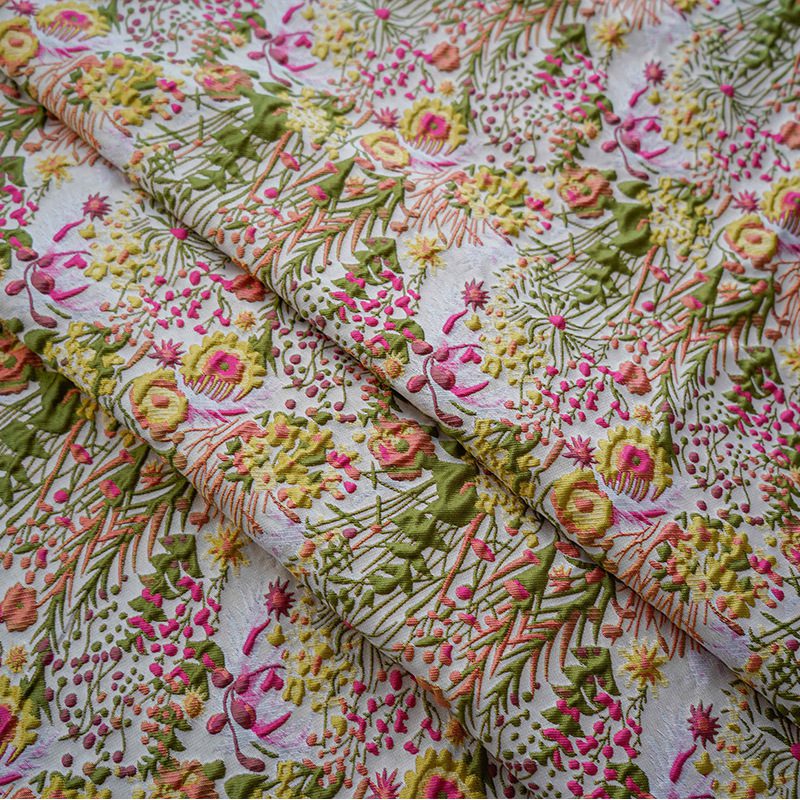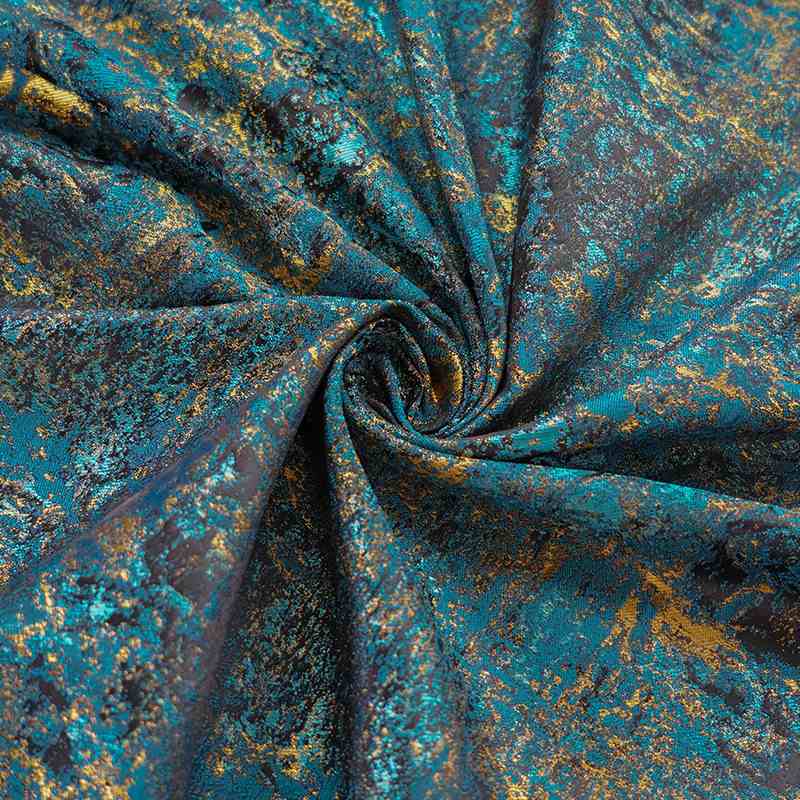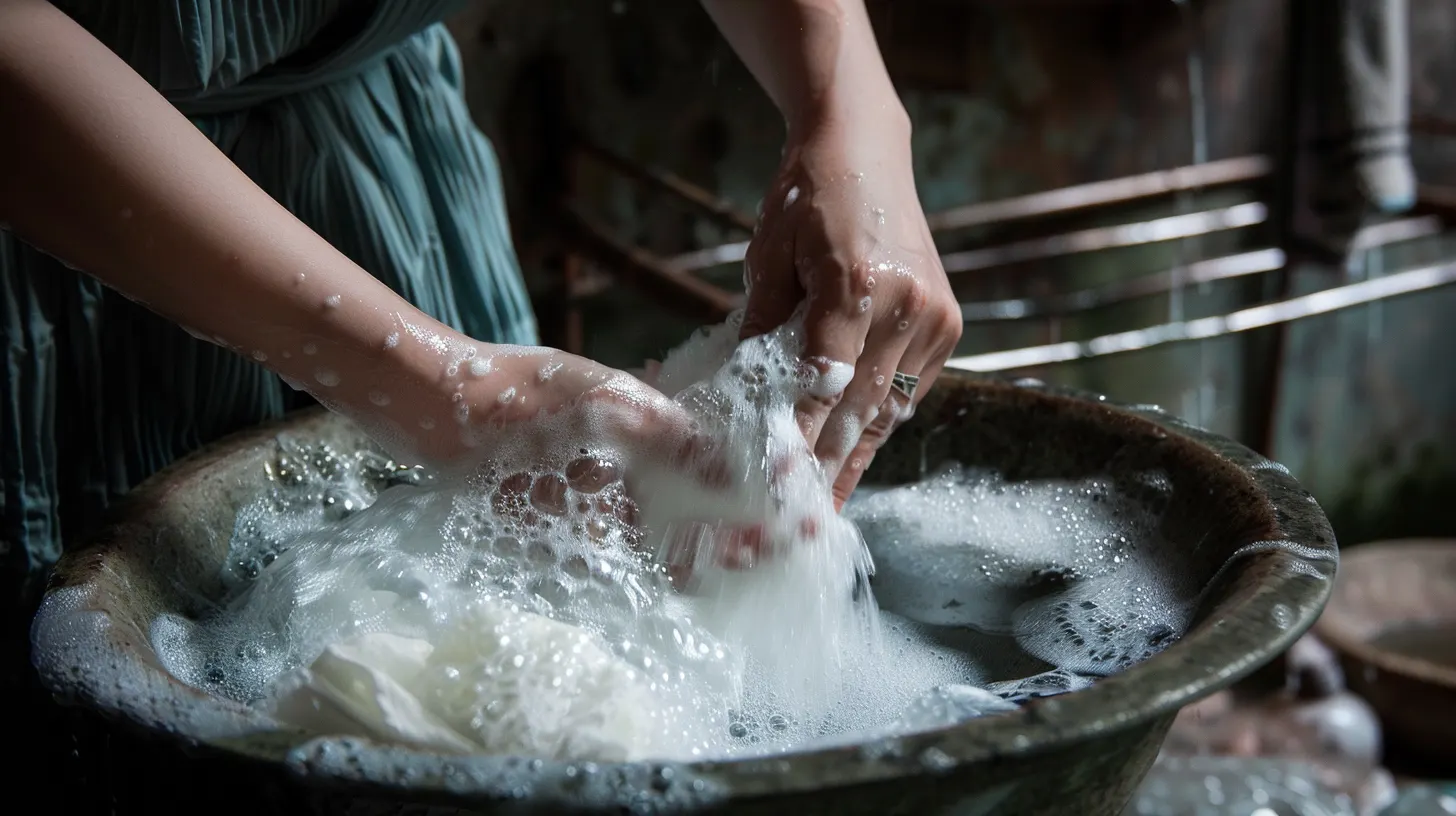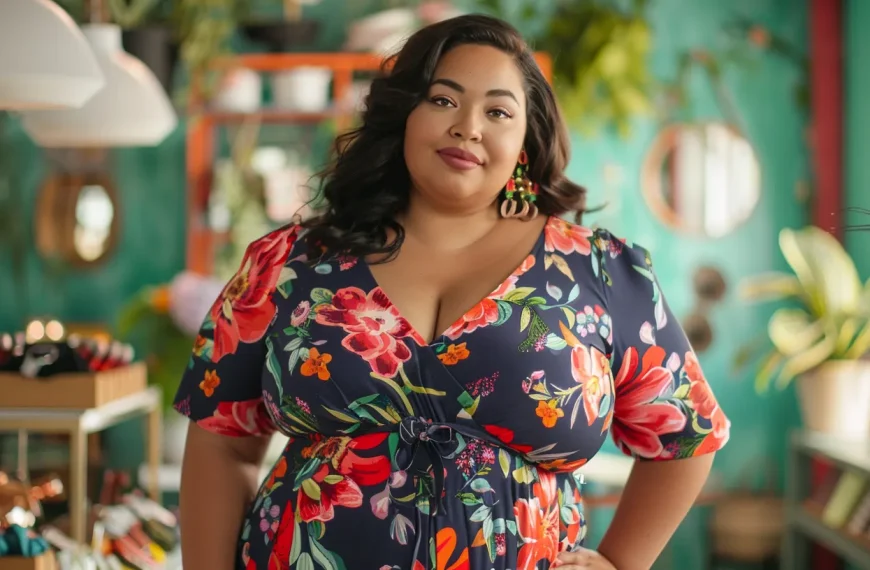How is brocade made? The brocade is woven using shuttle-weaving techniques. You start with luxurious threads, as smooth as silk, and skillfully transfer intricate designs onto meticulously coded cards. The cards control a Jacquard loom that weaves intricate and raised patterns, perfectly reflecting the encoded design. The warp and weft interlace precisely to display the design within the fabric, not merely on top. Dyeing adds color, while calendaring lends a smooth finish. It’s meticulous, historic artistry, bridging ancient practices with modern technology. There’s much more to this opulent fabric’s journey than meets the eye.
Key Takeaways
- Brocade fabric is created by encoding intricate patterns onto Jacquard loom punch cards.
- The weaving process involves using warp and weft threads to create a raised pattern, giving brocade its characteristic embossed look.
- For more complex designs, the Jacquard loom is manually controlled to weave the intricate patterns.
- Once woven, the fabric undergoes a dyeing process to add color and enhance its aesthetic appeal.
- The final step is calendaring, which makes the fabric smooth and increases its durability.
Everything You Need to Know about Brocade Fabric
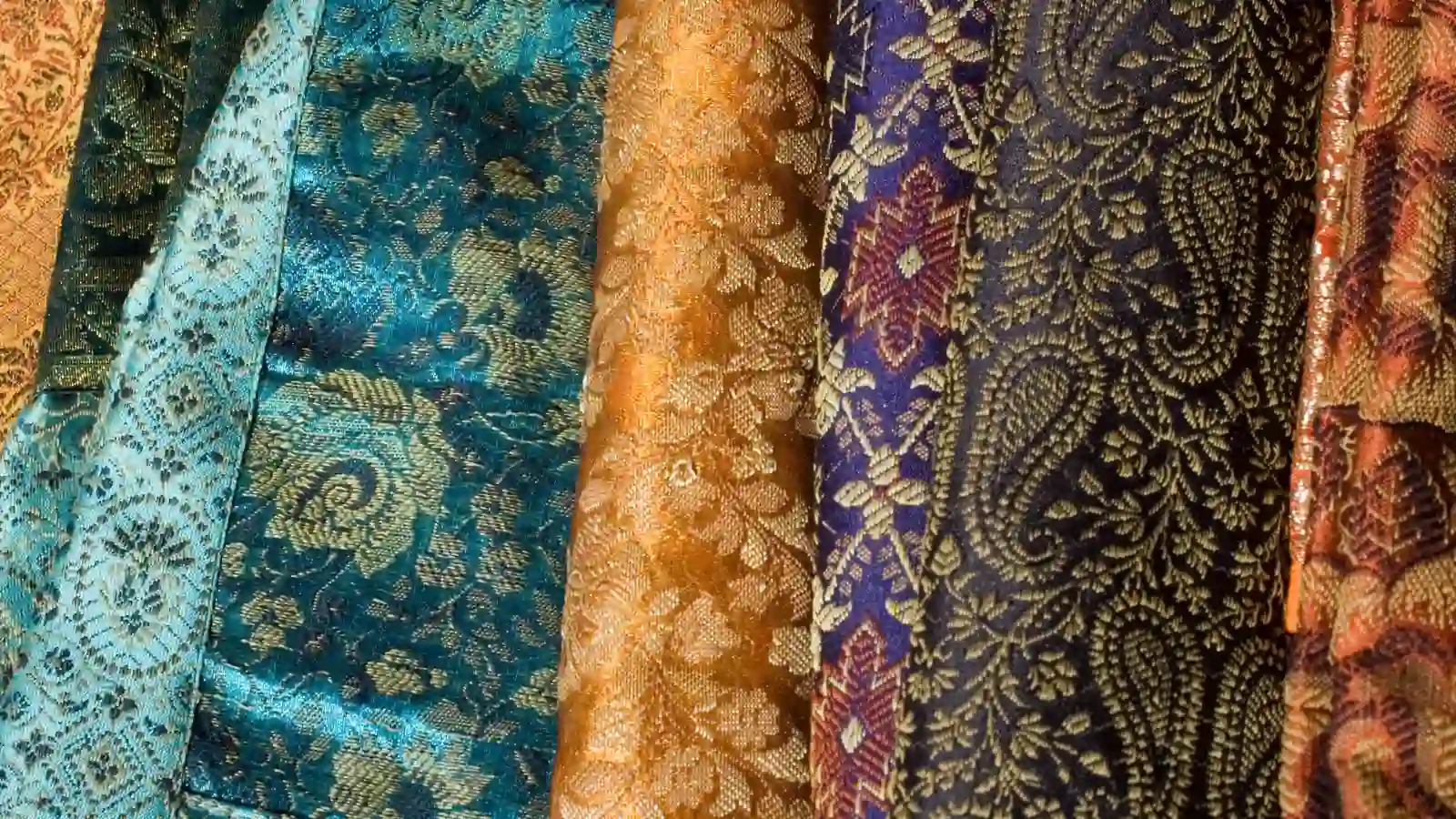
Do you have brocade garments or brocade dresses? You might wonder what exactly is brocade fabric? Well, it’s a richly detailed and textured fabric with a history that traces back centuries.
We’ll explore its origins, types, and applications, giving you a comprehensive understanding of this luxurious fabric.
What is Brocade Fabric?
Brocade fabric features additional weft threads that create intricate ornamental designs. This fabric provides a magnificently luxurious appearance with exquisitely detailed patterns. You’ll typically find this fabric made from materials like silk, providing a rich texture that exudes elegance. The complex weaving process, usually done on a jacquard loom, makes sure that the design is an integral part of the fabric, not added on through embroidery. This supplementary weft technique creates an embossed or quilted look, adding depth to the fabric’s surface.
It’s essential to note that brocade, despite its opulent look, requires delicate care to maintain its integrity. Whether used in clothing or home decor, brocade fabric is undeniably a symbol of craftsmanship and luxury.
History of Brocade
Brocade fabric has a rich history originating from ancient China, Byzantium, and India. Learning about its heritage will help you better appreciate its craftsmanship and luxurious appeal.
Brocade fabrics are traditionally made with silk threads on a draw loom, often favored by nobility. The weaving patterns, complex and ornate, are achieved by introducing additional weft threads. It contributes to its unique raised design.
Over the centuries, China, Italy, and India have emerged as significant producers of this exquisite material. Today, brocade is still admired for its intricate artistry and opulence, despite the evolution of production techniques, which is a testament to its enduring appeal.
Different Types of Brocade Fabric
There are different types of brocade fabric, each with its own characteristics that suit different needs and preferences. Silk brocade, for instance, is renowned for its luster and softness. So it is a perfect choice for luxurious garments. Metallic brocade incorporates shiny metal threads that add a festive touch, ideal for formal wear.
If you’re after durability and wrinkle resistance, polyester brocade could be your best choice. Cotton brocade, being lightweight, is suitable for summer outfits. Then, there are blends that combine the benefits of different materials.
Knowing these types helps you pick the right brocade for your project. Remember, the choice of brocade fabric can greatly influence the final product’s look and feel.
What is Brocade Fabric Used for?
Brocade material is very popular and used in various fields. You can use brocade fabric for luxurious garments, opulent curtains, and ceremonial clothing in your projects. Brocade fabric is used to make fancy clothes for formal events, traditional ceremonies, and historical reenactments. It’s known for its detailed designs.
You’ll also find it adding a touch of elegance to upholstery and draperies, enhancing the aesthetic appeal of any space. However, it’s not just for high-end fashion and decor. Brocade’s versatility allows it to be incorporated into casual wear too, offering a timeless, regal look.
Whether it’s for fashion or home decor, brocade fabric lends a sense of luxury and sophistication that’s hard to match.
How is Brocade Fabric Made?
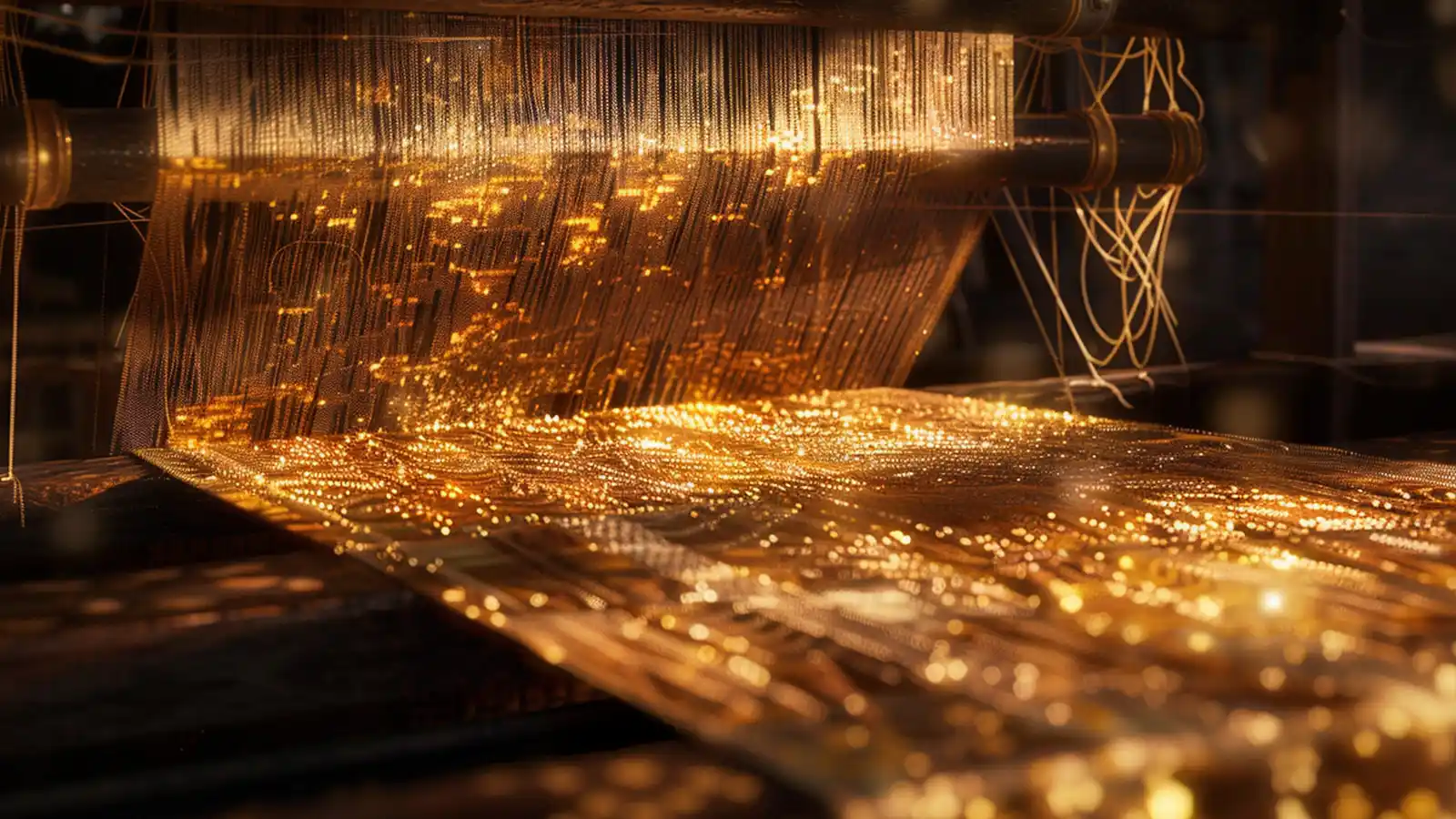
How is the brocade fabric produced? To create brocade fabric, you start by translating designs into coded cards, which guide the loom in weaving intricate patterns.
You then use the warp and weft threads to create the distinctive raised pattern that characterizes brocade.
Translate Designs into Coded Cards and Create Fabric Patterns
To make brocade fabric, you start by turning your brocade designs into coded cards that will be used to weave the fabric. This step is crucial for computerizing Jacquard looms. The loom uses cards to make intricate brocade patterns by lifting warp threads to add extra weft threads.
Here are some key points to remember:
- Each coded card corresponds to a specific row of the design, defining the precise weaving pattern.
- Skilled artisans input the design information into the jacquard loom.
- The loom interprets the coded cards and determines which warp threads to lift.
This method enables the creation of elaborate, raised designs characteristic of brocade textiles.
Use Warp and Weft to Create the Raised Pattern
To make brocade fabric, you can use a combination of warp and weft yarns to create the raised patterns that make it luxurious.
The warp threads, typically silk or cotton, serve as the foundation, running vertically on the loom. The weft threads, which can be silk, synthetic, cotton, or even metallic fibers, are woven horizontally across the warp. These threads are responsible for creating the intricate designs that set brocade apart.
Using a specific weaving technique, you’ll guide the weft threads over and under the warp threads at specific intervals. This process is what forms the raised patterns.
The jacquard process, a modern innovation, has revolutionized brocade production, allowing you to achieve even more complex and detailed designs.
Control Jacquard Loom to Weave the Fabric
Controlling a Jacquard loom is crucial for weaving brocade fabric because it enables weaving detailed patterns into the material. This loom revolutionized brocade production by allowing for precise control over individual warp threads, resulting in detailed motifs.
By using a Jacquard loom, you can:
- Create complex and varied designs by controlling the interlacing of warp and weft threads.
- Achieve intricate patterns and raised designs that are characteristic of brocade.
- Utilize computer programs or punched cards to dictate the weaving pattern.
Finish Touches about Dyeing and Calendaring
After weaving, color is added to the brocade fabric through dyeing. This technique enhances its appearance and allows for a variety of aesthetic styles.
Vat dyeing gives a deep, rich color, while digital printing allows for intricate, multicolored designs.
Post-dyeing, the fabric undergoes calendaring, where it’s passed through heated rollers. This step gives the brocade a smooth finish, removing any wrinkles and imparting a luxurious sheen.
Dyeing and calendaring make brocade look better and last longer. Thus, these finishing touches are pivotal in producing high-quality brocade fabric.
Conclusion
You’ve learned about the production of brocade, including choosing materials like silk or polyester, and weaving on looms.
You’ve discovered the time-honored techniques that birth the stunning raised designs. And you’ve seen the care required to maintain brocade’s elegance and durability.
Hopefully, you’ll now appreciate not just the beauty, but the craftsmanship behind every piece of brocade fabric. Truly, it’s a testament to the enduring blend of tradition and innovation.
Learn more about fabric knowledge at Longan Craft Blog, and dive into the fabric world with Longancraft!
Related Products:

